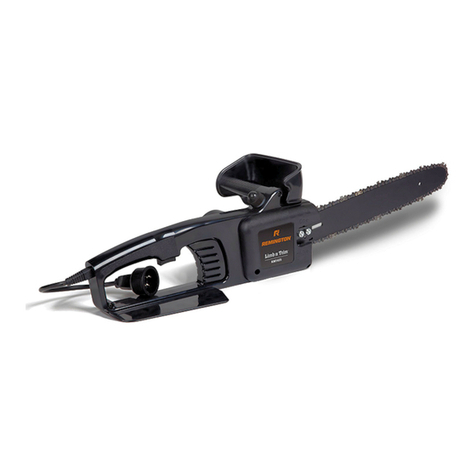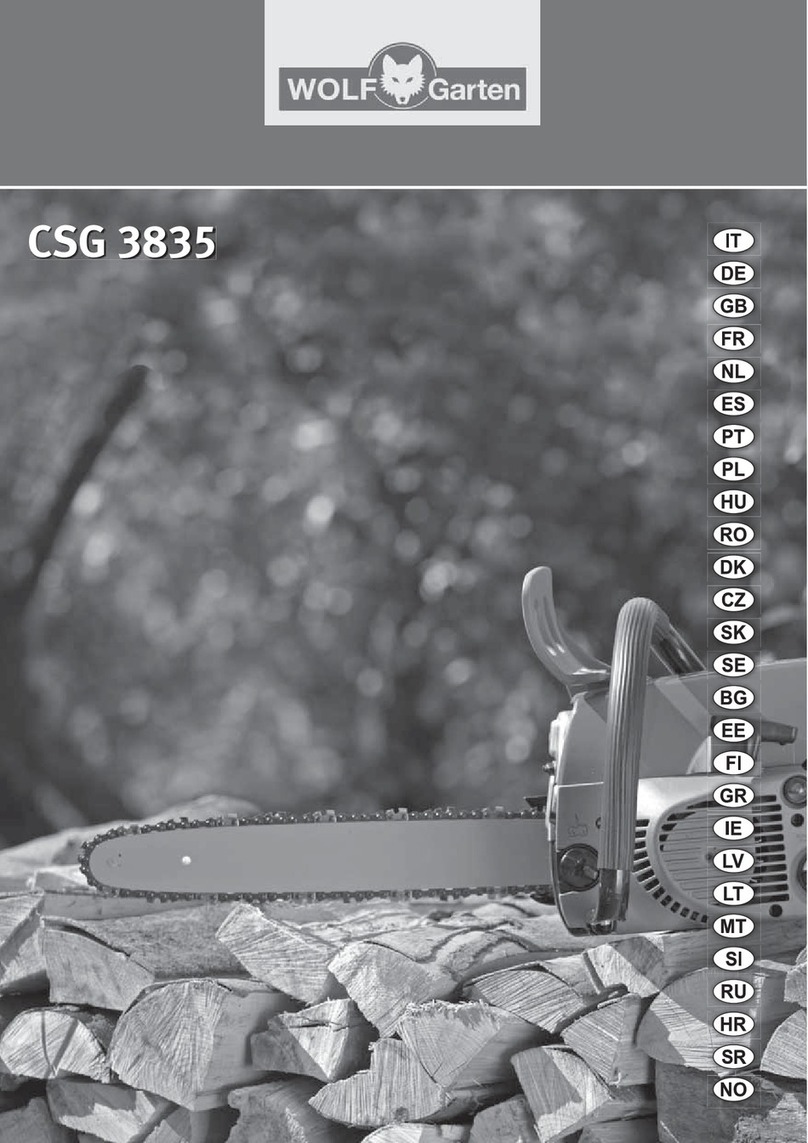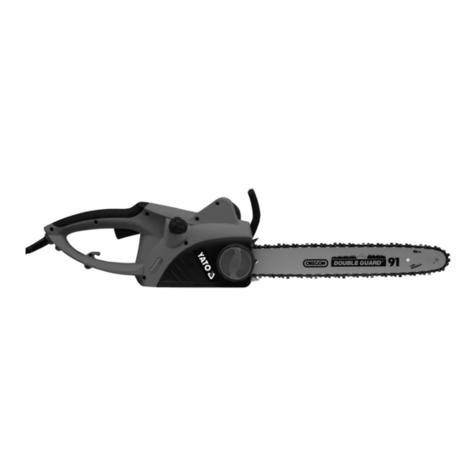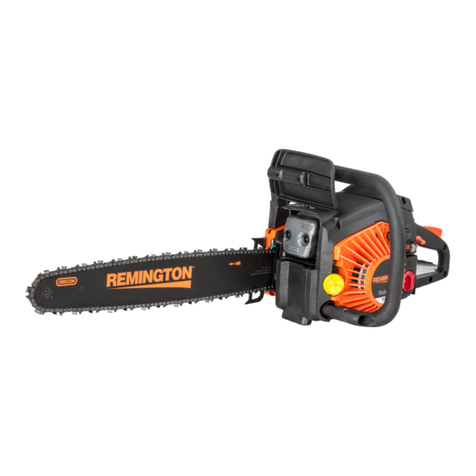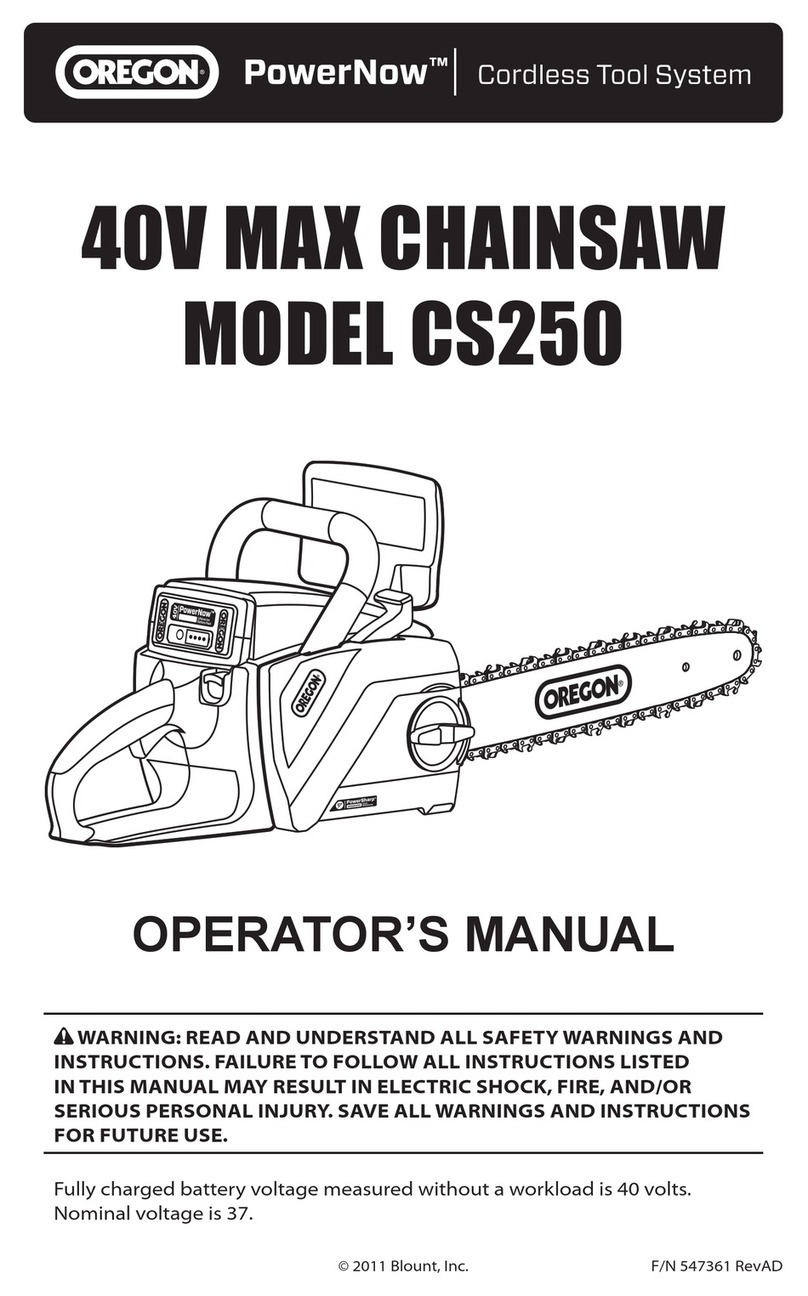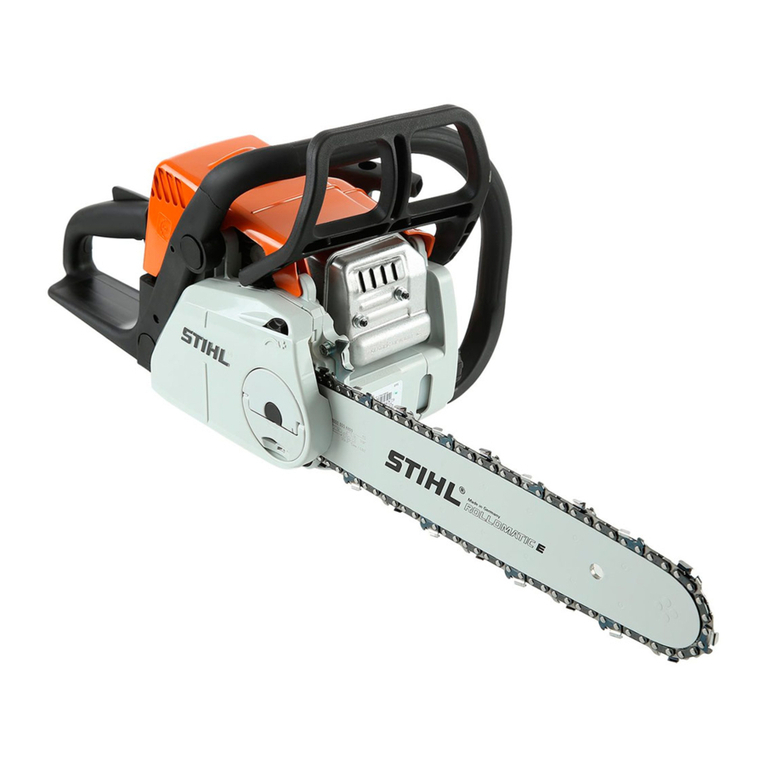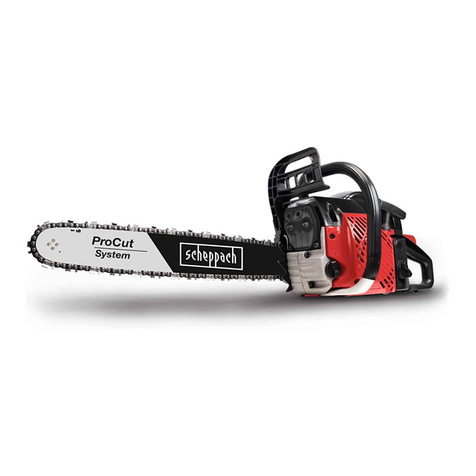CSA ER2 Series User manual

To Customer
This manual contains specific information related to large capacity models. Before use, please read and comply with all
the content of the "ER2 Series Electric Chain Hoist (125kg to 5t) Owner's Manual" (separate publication) as well as this
manual to ensure proper use of the products.
Suspended with
Hook : ER2
Motorized Trolley : ER2M
Manual Trolley : ER2SG
Supplementary Manual
ER2 Series Electric Chain Hoist (7.5t to 20t)
Approved by CSA
Owner's Manual
OM-ER2LZZ-KC0-01

2
Safety Precautions
Table of Contents
CAUTION
This owner’s Manual provides specific information regarding the ER2 electric chain hoist (7.5t to 20t). Before operating the product,
be sure to read and comply with all the contents of this Manual and the ER2 Series Electric Chain Hoist (125kg to 5t) Owner’s
Manual to operate the product correctly.
Safety Precautions ........................................................................................................2
Product Specications and Operational Environment ..............................................3
• Standard Specications....................................................................................3
• Operational Environment..................................................................................5
Nameplate and Product Code ......................................................................................6
• Nameplate of Electric Chain Hoist ...................................................................6
• Nameplate of Manual Trolley ............................................................................7
• Product Code of Large Capacity .....................................................................7
Checks on Unpacking ..................................................................................................8
• Checking Chain Stamps ...................................................................................8
• Recording the Product No. ...............................................................................8
• Recording the Initial Value ................................................................................8
Assembling ....................................................................................................................9
• Installing a Chain Container .............................................................................9
• Checking Power and Power Cable.................................................................13
• Connecting Cables ..........................................................................................15
Regular Inspection ......................................................................................................20
• Daily Inspection ...............................................................................................20
• Frequent Inspection ........................................................................................21
• Periodic Inspection..........................................................................................23
Appendix ......................................................................................................................27
Wiring Diagram ............................................................................................................27
Mandatory

3
Product Specifications and Operational Environment
■Standard Specifications
Short-time rating : ER2 (100% of rated load) - 60 minutes,
MR2 (100% of rated load) - 30 minutes
Intermittent rating : ER2 (63% of rated load) - 60% ED, MR2 (63% of rated load) - 40% ED
Hoist classification : ISO-M4, FEM-2m, ASME-H4
Protection : Hoist IP55, Push Button Switch IP65
Push button control : 3-push button switch for hook or manual trolley suspension, / 5 or 7-push button control for
motorized trolley suspension
Lift : 3m (standard)
Power supply method : Cabtyre cable
Color : KITO Yellow (Equivalent to Munsell 7.2YR6.5/14.5)
Braking capacity : 150% or more
Applicable rail type : I beam, H beam
Applicable rail width : 150mm – 308mm
Power supply cable : Standard length - 10m
Voltage & motor :
Product category Motor Insulation
Class
Voltage range Operating Voltage
60Hz
230/460V Class B 220V
110V440V
500V Class B 575V
* For more information about the operating conditions and environment, refer to the ER2 Series Electric Chain Hoist
(125kg to 5t) Owner’s Manual, and for the standard dimensions refer to the appendixes in this manual.
The operational environment of the electric chain hoist and motorized trolley is as follows:
NOTE
• Operate the electric chain hoist at the rated voltage.
•Do not use the electric chain hoist beyond the short time and intermittent ratings.
* Hoist classification
Capacity (t) Code ISO ASME FEM
7.5 ER2-075S
M4 H4 1Am
10 ER2-100L
ER2-100S
15 ER2-150S
20 ER2-200S
Product Specications and Operational Environment
Standard Specications

4
ISO 4301 specifies the total operating hour (service life) of gears and bearings according to the loading status. For example,
the total operating hour (service life) of the mechanism for M5 constantly subjected to the rated load is 1,600 hours. The total
operating hour reaches 6,300 hours under a medium load.
*Rate of loading
Light : A case where the capacity is rarely applied. Usually the hoist is used with a light load.
Medium : A case where the capacity is applied considerably frequently. Usually the hoist is used with a medium load.
Heavy : A case where the capacity is applied considerably frequently. Usually the hoist is used with a heavy load.
Ultra heavy : A case where the capacity is applied constantly.
Loading status Total operating hour h
800 1600 3200 6300 12500
Light M4 M5
Medium M4 M5
Heavy M4 M5
Ultra heavy M4 M5
●ISO
Hoist duty class Typical areas of application
Operation time ratings at K=0.65
Unlformly distributed
work periods
Infrequent
work periods
Max. on
time, min / hr
Max. No.
starts / hr
Max. on time from
cold start, min
Max. No.
of starts
H2
Light machine shop fabricating, service,and
maintenance; loads and utilization randomly
distributed; capacitys infrequently handled.
7.6 (12.5%) 75 15 100
H3
General machine shop fabricating,
assembly, storage, and warehousing; loads
and utilization randomly distributed.
15 (25%) 150 30 200
H4
High volume handing in steel warehouses,
machine shops, fabricationg plants and mills,
and foundries; manual or automatic cycling
operations in heat treating and plating; loads
at or near capacity frequently handled.
30 (50%) 300 30 300
●ASME HST
• The grade symbols are identical to those of ASME HST-1M. (Performance standard for Electric Chain Hoist)
Relation between ISO-and FEM-Denominations
1 Dm 1 Cm 1 Bm 1 Am 2 m 3 m 4 m 5 m
M 1 M 2 M 3 M 4 M 5 M 6 M 7 M 8
Load
spectrum
Cubic
mean value
Class of operation time
V0.06 V0.02 V0.25 V0.5 V1 V2 V3 V4 V5
T0 T1 T2 T3 T4 T5 T6 T7 T8
Average operation time per day in hours
0.12 0.25 0.5 1 2 4 8 16 >16
1 L1 K 0.50 – – 1 Dm 1 Cm 1 Bm 1 Am 2 m 3 m 4 m
2 L2 0.50<K 0.63 – 1 Dm 1 Cm 1 Bm 1 Am 2 m 3 m 4 m 5 m
3 L3 0.63<K 0.80 1 Dm 1 Cm 1 Bm 1 Am 2 m 3 m 4 m 5 m –
4 L4 0.80<K 1.00 1 Cm 1 Bm 1 Am 2 m 3 m 4 m 5 m – –
Class of
operating
time
Average
operating
time per day
(in hours)
Calculated
total operating
time
(in hours)
V0.06 T0 0.12 200
V0.12 T1 0.25 400
V0.25 T2 0.5 800
V0.5 T3 1 1,600
V1 T4 2 3,200
V2 T5 4 6,300
V3 T6 8 12,500
V4 T7 16 25,000
V5 T8 >16 50,000
●FEM
• The grade symbols are identical to those of FEM 9.511.
(Rules for Design of Serial Lifting Equipment: Classification of Mechanisms)
Product Specications and Operational Environment
Standard Specications

5
■Operational Environment
Ambient temperature : -20°C to +40°C
Slope of rail : No slope of travelling rail (for the hoist with trolley)
Ambient humidity : 85 % or less (no condensation)
Explosion-proof construction : Not applicable to the work environment with explosive gases or explosive vapor
Environment to be avoided : A place with organic solvent or volatile powder, and a place with a plenty of powder and
dust of general substances
: A place with considerable amount of acids and salts
NOTE
When installing the electric chain hoist outdoors or to the place where the hoist is exposed to direct rain,
wind and snow, shelter the hoist under a roof to protect it from rain, wind and snow.
Product Specications and Operational Environment
Operational Environment

6
■Nameplate of Electric Chain Hoist
TROLLEY MORTOR
HOIST MORTOR
(MOTOUR DU PALM)
(MOTOUR DU CHARIOT)
CODE
PHASE
VOLT (VOLT)
HEARTZ
HP (CV)
AMP (A)
AMP (A)
AMP (A)
AMP (A)
HP (CV)
HP (CV)
HP (CV)
SERIAL NO. (No.SERIE)
MADE IN JAPAN (FABRIQUE AU JAPON)
①
②
③
④
⑤
1 · · · Capacity Ex. 10t
The maximum mass of the load that can be imposed on the product. The mass of the hook is excluded.
2CODE · · · Product code Ex. ER2-100S
The code is denotations composed of product model, capacity, lifting speed.
3SERIAL No.
Serial number to indicate the manufacturing sequence of the product.
4HOIST MORTOR · · · Lifting motor
5 TROLLEY MORTOR · · · Traversing motor
Nameplate and Product Code
Nameplate and Product CodeNameplate of Electric Chain Hoist

7
■Product Code of Large Capacity
Capacity
Code
Electric chain hoist Motorized trolley Manual trolley
(geared trolley)
Body size Standard speed Low speed Low speed
7.5t
ER2-F
ER2-075S - MR2-075L TSG075
10t ER2-100S ER2-100L MR2-100L TSG100
15t ER2-150S - MR2-150L TSG150
20t ER2-200S - MR2-200L TSG200
■Nameplate of Manual Trolley
1 · · · Capacity Ex. 10t
The maximum mass of the load that can be imposed on
the product. The mass of the hook is excluded.
2 LOT No.
Manufacture No. to identify the time of manufacture and
the quantity of a production unit.
3 SERIAL No.
Serial number to indicate the manufacturing sequence of
the product.
①
②
③
Nameplate and Product Code Nameplate of Manual Trolley / Product code of large capacity

8
Checks on Unpacking
Capacity Load Chain : diameter (mm) Stamp interval
7.5t
11.2 12 links
10t
15t
20t
RH-DAT 0000 RH-DAT
Stamp interval
First stampSecond stamp Second stamp
Front side : RH-DAT
or FT-DAT
Back side : H-23
Front side : Lot No. of the Load Chain
(4 digits)
Back side : KITO
After unpacking, confirm chain stamp, and make a record of serial number and an inspection
as shown below.
•Be sure to check that the Load Chain is for the electric chain hoist ER2. The Load Chain of
other models (such as model ES or ER) or for different capacity cannot be used.
Failure to use a proper chain may result in death or serious injury due to the drop of the lifted load.
Mandatory
Mandatory
The load chain identification stamp (RH-DAT) is indicated on at intervals of chain links. Make sure that the Load Chain is
of a chain size (wire diameter) appropriate for ER2 referring to the table below.
DANGER
DANGER
●For later maintenance or inspection, at the time
of unpacking, fill in the table in the right with the
dimension "a" between embossed marks on the
Bottom Hook, the width of the hook "b" and the
thickness of the hook "c". (These values are used
for checking. Please also record the value for the
top hook of ER2 when your product is suspended
with a hook.)
Initial dimensions
Embossed marks
Top Hook
(For ER2 only)
Dimension a
mm
Dimension b
mm
Dimension c
mm
Bottom Hook
Dimension a
mm
Dimension b
mm
Dimension c
mm
●Fill in the table in the right with product's Lot No.,
Serial No. (described in the product nameplate),
date of purchase and the name of the sales shop
where you purchased the product.
* When requesting repair or ordering a hoist part,
please inform us of these pieces of information
together.
Item
Electric chain hoist
Motorized trolley Manual trolley
Lot No. ER2A– MR2A– TS2–
Serial No.
Date of purchase
Name of the sales shop
■Checking Chain Stamps
Checks on Unpacking
Checking Chain Stamps / Recording the Product No. / Recording the Initial Value
■Recording the Product No.
■Recording the Initial Value

9
•The each type of Chain Container has the capacity to store the specific amount of the Load
Chain. Use the Chain Container in correct capacity.
An chain overflow from the overstored container or a drop of container improperly installed on the hoist can cause quite
dangerous situation, resulting in fatal or serious injury.
Failure to have the maintenance personnel install the Chain Container may cause fatal or serious injury.
Before installation of the container, please also check the container capacity of the hoist and lifting height as shown on the
container.
Mandatory
Assembling
•Only qualified maintenance personnel or experts are allowed to assemble and disassemble the
electric chain hoist.
Assembly or disassembly of the hoist by incompetent personnel may result in death or serious injury.
Prohibited
■Installing a Chain Container
■Preparation for Assembling
• To facilitate mounting the chain container, hang the hoist body.
• Check that the stopper and the cushion rubber are attached to the third link from the end of the no-load side chain (the
side without the Bottom Hook).
■Assembling
The two types of the Chain Container are provided: canvas and steel
This manual describes the method to combine the canvas Chain Container with the body size of the electric chain hoist.
Refer to the separate “Mounting Manual of the Steel Chain Container" for the steel Chain Container.
•When storing the Load Chain into the Chain Container, put the end of no-load side chain first
and then store the rest of the Load Chain in order.
Failure to comply with these instructions may causes bodily injury or loss of property.
Mandatory
CAUTION
●Chain Container Seal
A seal in the right to indicate the hoist capacity and the maximum
lift is attached to the Chain Container. Be sure to check it before
installation.
Assembling Installing a Chain Container
DANGER
DANGER

10
1) Install 2 container chains to the chain
container with socket bolts, plain washers,
and lever nuts.
2) Install the lug of the container on the chain
guide A at the bottom of the hoist with the
bolts and lever nuts.
3) Insert the socket bolt through a plate of
the Connection yoke, both end links of
container chains and the other plate and
fasten them with plain washers and lever
nuts.
1) Install 2 container chains to the chain
container with socket bolts, plain washers,
and lever nuts.
2) Install the lug of the container on the chain
guide A at the bottom of the hoist with the
bolts and lever nuts.
3) Install 2 container chains to the container
suspender with the socket bolts, plain
washers and lever nuts.
●7.5t, 10t(L)
●10t(S), 15t(S), 20t(S)
Container
suspension wheel Socket bolt
Plain washer
Container chain
Socket bolt
Plain washer
Chain container
Connection Yoke
Lever nut
Socket bolt
Container chain
Lever nut
Socket bolt
Plain washer
Chain container
Fix with bolt
and lever nut.
Fix with bolt
and lever nut.
Lever nut
Lever nut
AssemblingInstalling a Chain Container

11
Installing a Chain Container
For I beam For H beam
Inner
Side plate S
Suspension shaft
Outer
Suspender T
Fixing spacer
Side plate G
Thin spacer
Thick spacer
edisthgiRedistfeL
■Checking rails used for the trolley, and adjusting the collar
Although the product is shipped in conjunction as far as the order of the hoist and trolley is made, it is necessary to
adjust the collars to the width of your rail. When a rail width is specified upon order, the collars arrangement is made at
shipment. However, if you change to a different rail width, make correct collar adjustments as explained in this section.
●Rail and wheel profile
In the conjunction with the motorized or manual trolley, the profile of
the trolley wheel and the rail should meet. Check the profile of both the
rail and the wheel.
■Rail spacer arrangement
Improper spacer arrangement could result in missing, irregular running or dropping. Make correct adjustments of the
trolley spacers to the rail width as shown in the following the table.
●Motorized Trolley
Number of Adjusting Spacers
WLL (t)
Beam ange
width
Parts
(mm)
149
150 153 155 160 163 170 175 178 180
181
184
185 200 203 215 220 229 232 250 254 257 260 264 267 279 283 286 289 295 298 300 302 305
7.5
to
20
Thin spacer Inner
1+1 1+2 1+2 2+3 3+3 4+4 1+1 1+2 2+2 2+3 1+1 1+2 3+3 4+4 1+1 1+2 4+4 1+1 1+2 2+2 2+3 3+3 1+1 1+2 2+2 2+3 3+4 4+0 4+0 4+1 5+1
Outer6553206543652065065432654314432
Thick spacer Inner
1+1 1+1 1+1 1+1 1+1 1+1 2+2 2+2 2+2 2+2 3+3 3+3 3+3 3+3 1+1 1+1 1+1 2+2 2+2 2+2 2+2 2+2 3+3 3+3 3+3 3+3 3+3 3+4 3+4 3+4 3+4
Outer4444442222000055533333111110000
Fixing spacer Inner - - - - - - - - - - - - - - 2 2 2 2 2 2 2 2 2 2 2 2 2 2 2 2 2
Remarks: (1) Take note the numbers on spacers of inner side as follows.
Example 0+1
0: The number of spacers on the left side of the shaft
1: The number of spacers on the right side of the shaft
(2) Adjustment of trolley width :
Adjust the dimensions by appropriately increasing or decreasing the number of inner or outer adjusting
spacers, without strictly adhering to the number of adjusting spacers shown in the above table.
(3) Spacers arrangement example.
Number of Adjusting Spacers
Assembling

12
●Manual Trolley
Same as the Motorized Trolley table.
AssemblingInstalling a Chain Container

13
●Hook (ER2) and Manual Trolley (ER2SG) mount
Code
Capacity of fuse and circuit breaker (A)
Cable size
(AWG) 220/440V 500V class
- ER2SG075S AWG14 30/10 10
- ER2SG100L
ER2-100S ER2SG100S
AWG10 50/20 15ER2-150S ER2SG150S
ER2-200S ER2SG200S
●Motorized Trolley (ER2M) mount
Code
Capacity of fuse and circuit breaker (A)
Cable size
(AWG) 220/440V 500V class
ER2M075S-L AWG12 30/15 20
ER2M100L-L
ER2M100S-L
AWG10 60/30 20ER2M150S-L
ER2M200S-L
■Checking Power and Power Cable
Mandatory
DANGER
• Check that the source voltage meets the rated voltage of the electric chain hoist.
•Check that the rating of the breaker meets the specifications of the electric chain hoist.
Failure to comply with this instruction may result in death or serious injury.
Checking Power and Power CableAssembling

14
●Checking the Power Cable
Prohibited
Mandatory
Code
220/440V 500V class
Cable size
(mm²)
60Hz 50Hz
220-230V 415-440V
- ER2SG075S AWG14
(AWG12)
16
(28)
68
(119)
108
(189)
- ER2SG100L
ER2-100S ER2SG100S G10
(AWG8)
22
(32)
93
(136)
216
(378)
ER2-150S ER2SG150S
ER2-200S ER2SG200S
Code Cable size
(mm²)
220/440V 500V class
60Hz 50Hz
220-230V 415-440V
ER2M075S-L AWG12
(AWG10)
21
(34)
90
(142)
138
(217)
ER 2M100L-L
ER2M100S-L AWG10
(AWG8)
19
(28)
80
(117)
182
(319)
ER2M150S-L 17
(25)
71
(103)
158
(276)
ER2M200S-L
NOTE) Figures in parenthesis ( ) mean the cable one size larger than the standard size.
•Do not use the cable other than the accompanying cable or optional power cable.
Failure to comply with this instruction causes bodily injury or loss of property.
•Do not use the power supply cables beyond their maximum length or cable size.
Failure to comply with this instruction causes bodily injury or loss of property.
AssemblingChecking Power and Power Cable
CAUTION

15
NOTE
■Connecting Cables
Mandatory
Relay cable
for operation Connection box Cable holder arm
Cable holder
Holder B
Power cable
Holder A
Cable packing
Cord chain stopper
Protection wire
Pan head screw
Electric chain
hoist
Electric chain
hoist
Relay cable
for power
Relay cable for
operation
Socket (8P)
Socket holder
Lock ring
Plug (8P)
Socket (4P)
Plug (4P)
Lock ring
Plug (8P)
Socket (8P)
Relay cable
for power
•Do not fastening the cable plugs by using a tool and be sure to fasten them by hand.
Tightening excessively a connector may result in damaging or breaking plastic threads.
• To prevent the cable from disconnecting or coming off, secure the strain relief wire of the push button
cord to the hoist or trolley body.
•Be sure to turn off the power supply before wiring work.
Failure to comply with this instruction causes fatal or serious injury due to electrical shock.
■Hook Suspensions for 10t (S) or more
Connecting CablesAssembling
DANGER

16
2) Insert the plugs (8P) of the relay cable for operation into the sockets (8P) of each of 2
hoists, and securely tighten the lock rings.
1) Insert the plugs (4P) of the relay cable for power into the sockets (4P) of each of 2 hoists,
and securely tighten the lock rings.
●Connecting the relay cable
1)
Insert the plug (8P) of the push button swtich cord into the socket (8P), and securely tighten the
lock ring.
●Connecting the push button switch cord
2) Remove the cable packing from the power cable, and pass holder A through the power
cable.
1) Remove holder A installed on the connection box.
●Connecting the power cable
3) Pass the cable packing through the power cable (see the figure P15), and then insert it into
the connection box.
4) Tighten holder A, and fix the power cable to the connection box.
5) Connect the power cable to the terminal panel in the connection box.
(Refer to the wiring diagram on the connection box to perform wiring correctly.)
6) Fix the cable holder on the power cable to the cable holder arm.
2) Insert the cord chain stopper into the end ring of the protection wire, and fix the stopper to
the socket holder with a pan head screw.
AssemblingConnecting Cables

17
■Motorized Trolley
Relay cable
for operation
Connection box
Holder B
Power cable
Holder A
Cable packing
Cord chain stopper
Protection wire
Pan head screw
Electric chain hoist
Joining plate
Cord-support wire stopper
Protection wire
Pan head screw
Cable holder arm
Chain hanging pin B
Split pin
Slotted nut
Power cable
Cable
holder
Electric chain hoist
Relay cable for power
Relay cable for operation
Socket (8P)
Socket holder
Lock ring
Plug (8P)
Socket (4P)
Joining plate
Pan head screw
Cord-support wire
stopperr
Protection wire
Plug (4P)
Lock ring
Plug (8P)
Socket (8P)
Relay cable
for power
<15t-20t Push Button Switch Cord> <Trolley Power Cable Connection>
Holder nut Plate D
Holder B
Holder A
<Direct-mount Push Button Switch Cord Connection>
Assembling Connecting Cables

18
1) Remove holder A installed on the connection box.
2) Remove the cable packing from the power supply cable, and pass holder A through the
power cable.
3) Pass the cable packing through the power cable (see the figure P17), and then insert it into
the connection box.
4) Tighten holder A, and fix the power cable to the connection box.
●Trolley Type
1) Mount the cable holder, which the Power Cable is passed, to the cable holder arm using a chain
hanging pin B, a slotted nut and a split pin.
5) Connect the power cable to the terminal panel on the connection box.
(Refer to the wiring diagram on the connection box to perform wiring correctly.)
6) Fix the cable holder on the power cable to the cable holder arm.
●Connecting the power cable
1) Insert the plugs (4P) of the relay cable for power into the sockets (4P) of each of 2 hoists,
and securely tighten the lock rings.
2) Insert the plugs (8P) of the relay cable for operation into the sockets (8P) of each of 2 hoists,
and securely tighten the lock rings.
1) Insert the plug (8P) of the push button swtich cord into the socket (8P), and securely tighten
the lock ring.
●Direct-mount
1) Mount the Holder B, which the Push Button Switch Cord is passed, to the plate D using the holder
nut.
2) Connect the Push Button Switch Cord to the terminal panel of the Connection Box.
2) Insert the cord chain stopper into the end ring of the protection wire, and fix the stopper to
the socket holder with a pan head screw. For 15t and 20t, fix the cord-support wire stopper
to the joining plate with a pan head screw.
●Connecting the relay cable
●Connecting the push button switch cord
AssemblingConnecting Cables

19
Cable holder Cable holder arm
Connector Socket holder
Plug (8P)
Socket (8P)
Cord Support L
Pan head screw
Protection wire
Lock Ring
Plug (4P)
Pan head
screw
Socket (4P)
Cable Support L
■Manual Trolley Type (7.5t, 10t (L))
●Connecting the push button switch cord
●Connecting the power cable
1) Insert the plug (8P) of the push button swtich cord into the socket (8P), and securely tighten
the lock ring.
2) Fix the power cable to the cable holder with a affordable length.
1) Insert the plugs (4P) of the power cable into the sockets (4P) of each of 2 hoists, and
securely tighten the lock rings.
2) Insert the cord support L into the end ring of the protection wire and set the wire to the
notch of the cord support L, and fix the cord support L to the hoist body with a pan head
screw.
Assembling Connecting Cables

20
Regular Inspection
Mandatory
■Load chain
■Daily Inspection
■Hook, Idle Sheave
Item Check method Criteria When failed
Paint marks
on load chain
(except for
7.5t/10t – (L))
• Check visually. • No misalignment in position
(Misalignment between upper and lower of paint
marks must be within 1m.)
* Some misalignment due to differences in hoisting/
lowering speed and stop distance between the left
and right electric chain blocks is not a fault.
With no load, lower the
chains until both limit
switches are triggered.
Item Check method Criteria When failed
Tilt of bottom
hook
Tilt of idle
sheave
• Check visually and by
operation.
• No tilt
• Smooth rotation of the idle sheave and no tilt in
bottom hook when hoisting/lowering
Move the load chain
or bottom fixture to
remove accidental
rotation, catching, and
twisting.
Paint marks
•Carry out daily inspection before operation.
(When any abnormality is found during inspection, turn off the power, indicate “FAILURE" and ask the maintenance
engineer for repair.)
Failure to comply with this instruction causes fatal or serious injury.
For information about the items not shown in the following table, see the ER2 Series Electric Chain Hoist
(125kg to 5t) Owner’s Manual and perform the inspection.
Regular InspectionDaily Inspection
DANGER
This manual suits for next models
4
Table of contents
Languages:
Popular Chainsaw manuals by other brands
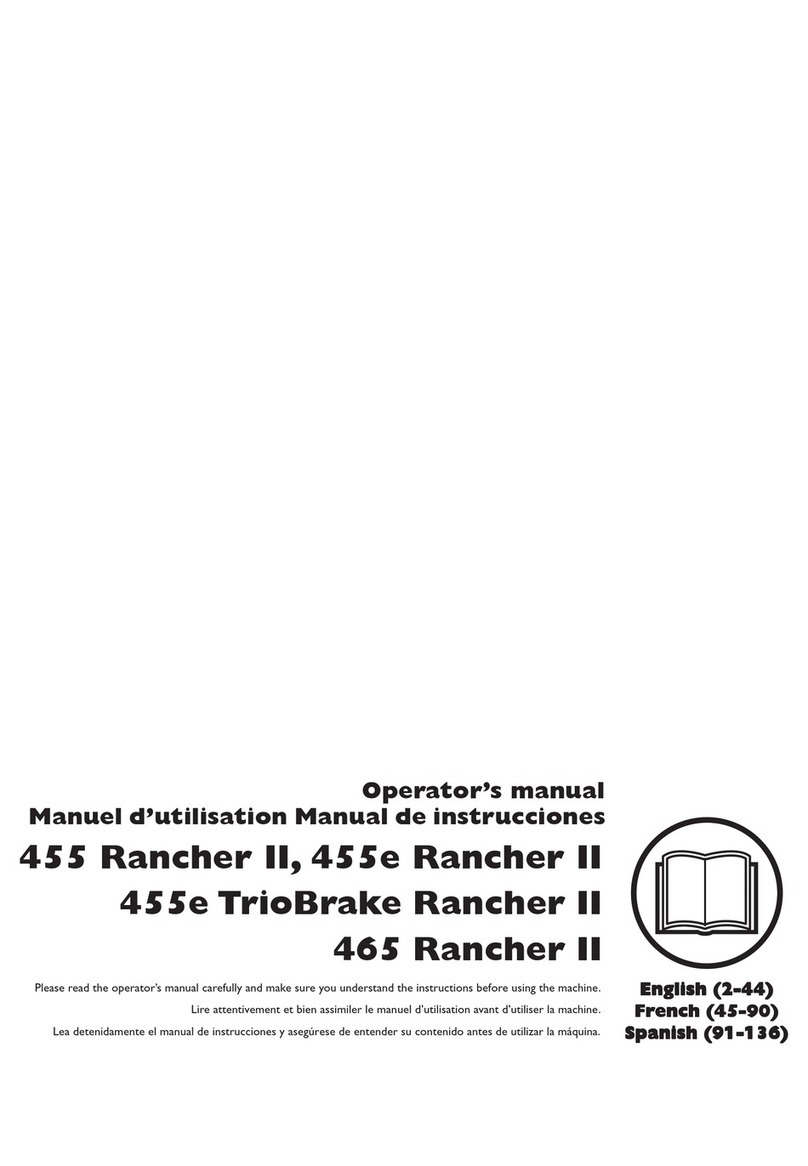
Husqvarna
Husqvarna TrioBrake 455e Rancher Series Operator's manual
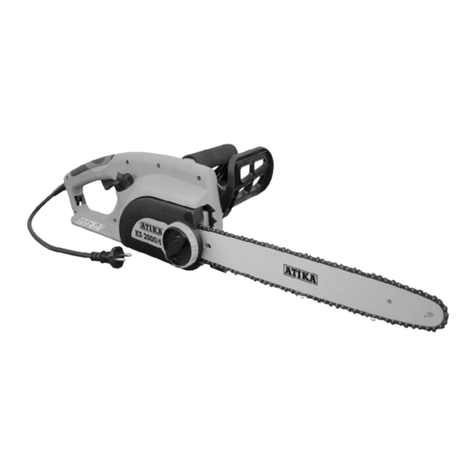
ATIKA
ATIKA KS 2000-40 - Operating manual – safety instructions – spare parts
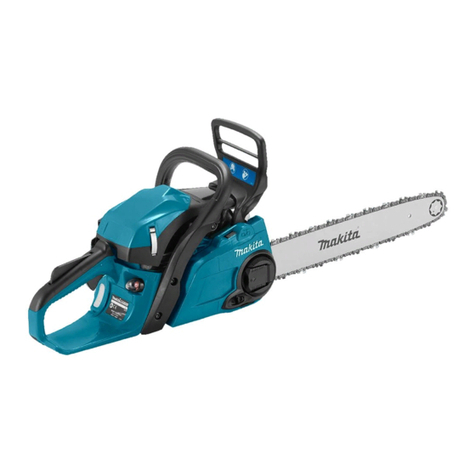
Makita
Makita EA3601F Original instruction manual
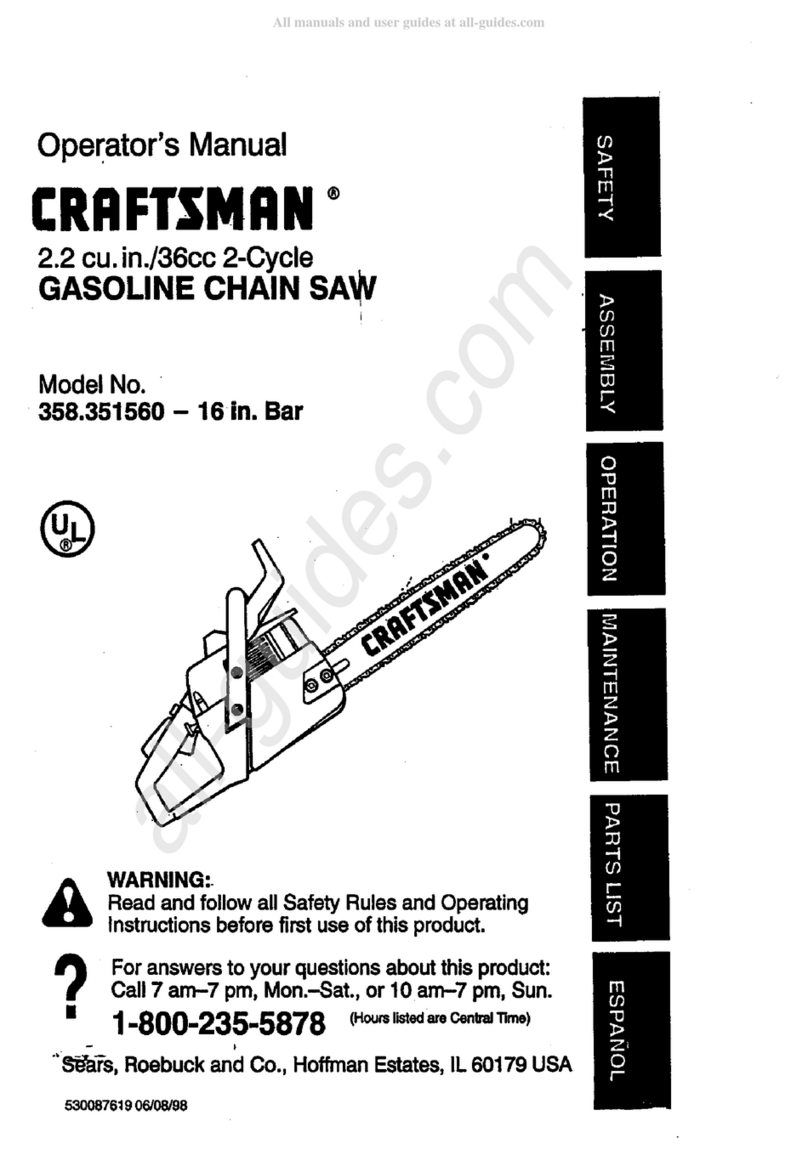
Sears
Sears Craftsman 358.351560 Operator's manual
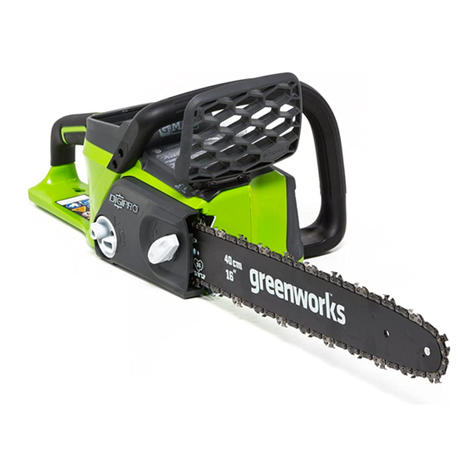
GreenWorks
GreenWorks 20152 owner's manual

Ryobi
Ryobi PCN3840-RY74005D, PCN4545-RY74 Operator's manual

